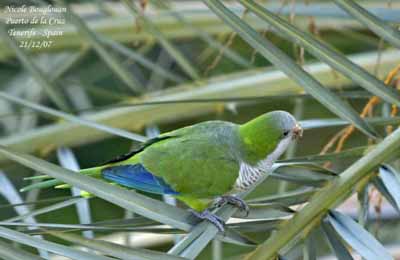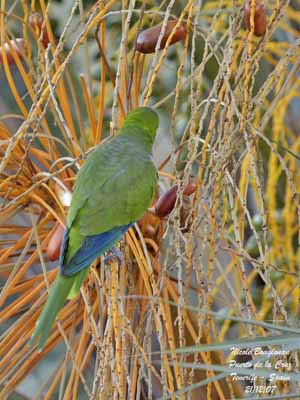
Monk Parakeet
Myiopsitta monachus
Psittaciforme Order – Psittacidae Family
BIOMETRICS:
Length : 28 à 30 cm
Wingspan : 43 à 48 cm
Weight : 90 à 120 g
LONGEVITY : Up to 20 years
DESCRIPTION:
Monk Parakeet is a small, stocky parrot, very popular as cage bird, but considered as a beautiful invader.
Monk Parakeet is mostly green with pale grey to whitish forehead, face, chin and throat. Breast is whitish barred with grey. Belly and vent are yellow.
Wings are dull green with blue-black flight feathers. Tail is long, with green uppertail, and pale blue-green undertail feathers.
Thick bill is pale flesh coloured to yellowish brown. Eyes are dark brown. Legs and feet are grey.
Both sexes are similar, with male larger than female.
Juvenile is bright green with greenish forehead.
Fr: Conure veuve
All : Mönchsittich
Esp : Cotorra Argentina
Ital : Parrocchetto monaco
Nd : Monniksparkiet
Russe : Попугай-монах
Sd : Munkparakit
Text and photographs by Nicole Bouglouan
Sources:
HANDBOOK OF THE BIRDS OF THE WORLD vol 4 by Josep del Hoyo-Andrew Elliott-Jordi Sargatal - Lynx Edicions - ISBN: 8487334229
PARROTS OF THE WORLD – An Identification Guide – by Joseph M. Forshaw – Princeton University Press – ISBN 0691092516
Wikipedia (Wikipedia, The Free Encyclopedia)
What Bird-The ultimate Bird Guide (Mitchell Waite)

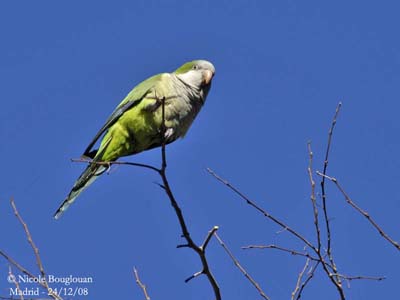
We can find four subspecies:
M.m. monachus, from SE Brazil, Uruguay and NE Argentina;
M.m. calita, from W and S Argentina;
M.m. cotorra, From SW Bolivia, Paraguay, N Argentina and S Brazil;
M.m. luchsi, from Bolivia. It is an isolated small population.
VOICE: SOUNDS BY XENO-CANTO
Monk Parakeet is very vocal and has wide vocabulary. It utters different sounds, such as screeches, squawks, screams, and continuous chatter at colonies. It is also able to imitate human speech.
We can also hear threat calls, uttered in territorial defence; alarm calls uttered in situations of danger or fear; flight calls, used by all birds of flock during take off; contact calls, gave by adults on long distance flights, or when they are with young; chatter calls used by birds at nest; distress calls uttered when bird is under stress, injured or held in hand.
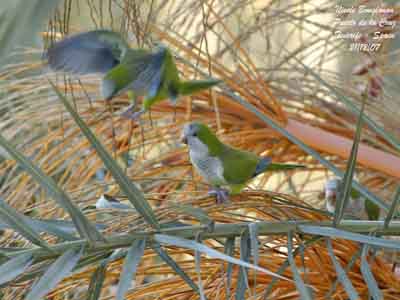
HABITAT:
Monk Parakeet is well adapted to urban and suburban areas, and it is common in parks. It nests in broad ranges of trees from palms to poplars.
Its distribution in North America includes wide range of habitats from high to low temperatures.
In South America, Monk Parakeet is common in semi-arid savannahs with scattered or isolated trees, and in woodlands, from sea level to 1,000 m, sometimes 1,800 m of elevation. It is particularly common near habitation.
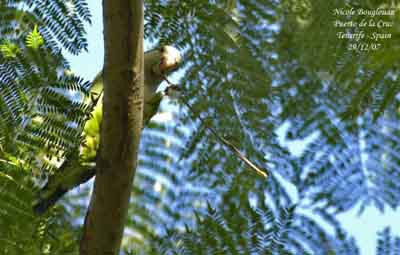
RANGE:
Monk Parakeet is native of Argentina and Brazil in South America. Introduced birds in US in 1960s as pets, escaped or released, began their proliferation through North America. An important population lives in Florida.
This species has been introduced in Europe, Israel, Bermuda, Puerto Rico, Canary Islands and Japan.
BEHAVIOUR:
Monk Parakeet is very gregarious. Birds gather in bands of up to 100 parakeets for foraging. While they are feeding, several birds act as sentinels around the group. Monk Parakeet may become a pest, damaging agricultural areas.
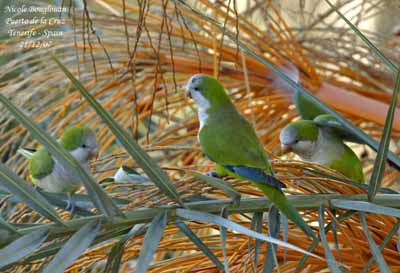
It uses its heavy bill for collecting food. It may take bits of large fruit, crack open pine cones to get the seeds, snip off dandelion’s heads for seeds and eat grass.

Monk Parakeet walks on the ground, using waddling gait. It also climbs easily with help of bill and feet. It roosts in communal nests year-round.
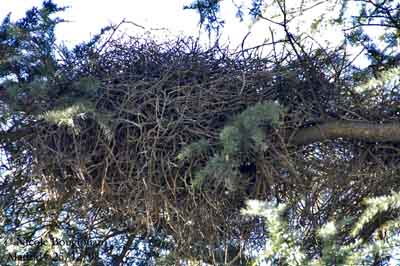
In South America, males fight when breeding season starts, but individuals from close nests fight year-round.
During threat displays, it has rigid attitude, body pointed forwards. It utters threat calls. Defence is restricted to nest colony. Monk Parakeet seems to be monogamous.
Courtship is very secretive, but we can observe mutual preening, begging displays, and crossing of beaks. After begging displays, both birds hold beaks while shaking heads vertically. Then, precopulatory feeding may occur. Pair copulates on perch close to nest or inside nest.
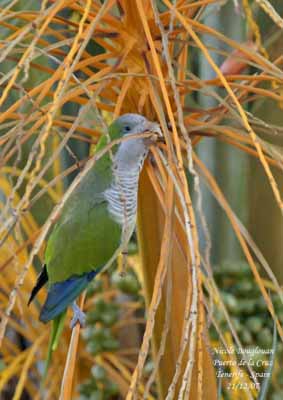
They may nest solitary or in colonies which may be a single compound nest or several nests forming an aggregation on a single tree or on trees close together.
In a compound nest, all members including non-breeding birds, bring material and share maintenance activities.
Monk Parakeets are preyed upon by snakes and some mammals which visit the nests for eggs and chicks. Sometimes, larger birds such as owls may use parakeet nests as platform for their own nest.
FLIGHT:
Monk Parakeet has swift and quick flight. It can frequently change in direction and altitude. When flying, wings remain at body level. It flies with rapid wing beats and relatively close to the ground, at about 10 m or less.
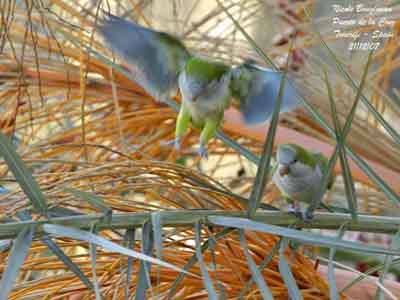
REPRODUCTION:
Monk Parakeet is the only member of its family which builds a nest in higher branches in trees, or any tall structure, natural or artificial. Nest is made with dry twigs, often thorny twigs for protection. It may nest colonially or solitary.
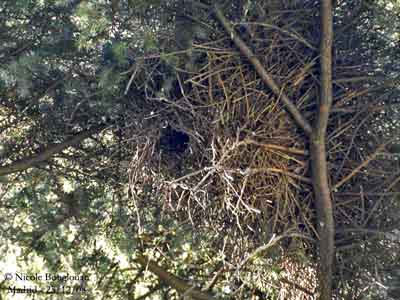
Nest may include only one chamber or more, exceptionally up to 200, in average, 1 to 20.
All members of a colony, adults and young, participate in building and maintenance. Construction begins with the floor, then the sides, and the roof. Entrance is often situated on underside of structure. Short tunnel drives to wider place where parakeets can turn around and pass, and then it arrives into globular brood chamber.
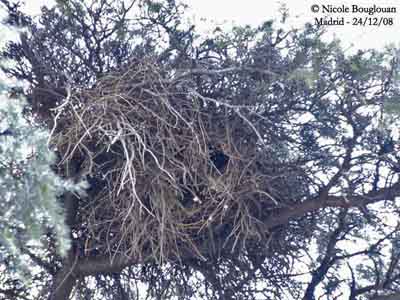
Some agglomerate nests may weight up to 1,200 kg.
Maintenance is a continuous activity all year round; nests are used all the year for roosting and reproduction.
Female lays 5 to 8 smooth, white eggs. Incubation lasts about 24 days, mainly by female. Male brings materials to female during incubation, and sometimes feeds her. Altricial chicks are sparsely covered with yellowish down. They are fed by both parents with regurgitated food. Young may leave the nest about 40 to 50 days after hatching, and they are fully grown and self-sufficient at this moment.
This species produces two broods per season, and three in captivity.
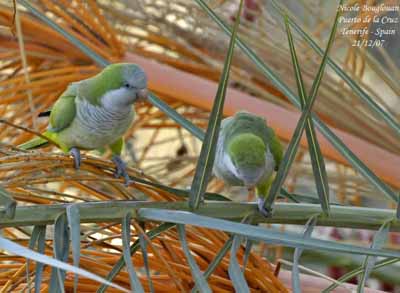
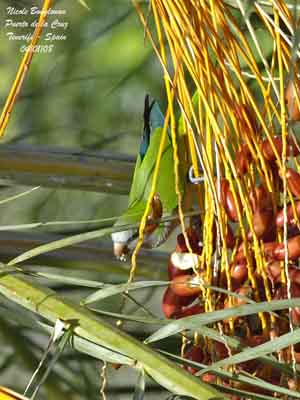
DIET:
Monk Parakeet is mainly granivorous, feeding on plants seeds, seeds of maize and sunflower, according to the season. It also consumes leaf buds, blossoms, fruits, nuts, berries and insects.
PROTECTION / THREATS / STATUS:
Monk Parakeet is an attractive cage birds and pet worldwide. It is also persecuted as agricultural pest, but damages seem generally light, with minor economic impact.
Monk Parakeet is common throughout its range.
